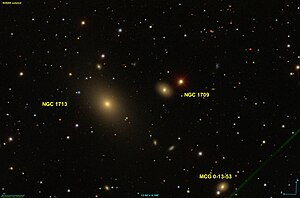NGC 1709
| Galaxy NGC 1709 |
|
|---|---|

|
|
| SDSS recording | |
| AladinLite | |
| Constellation | Orion |
|
Position equinox : J2000.0 , epoch : J2000.0 |
|
| Right ascension | 04 h 58 m 44.0 s |
| declination | -00 ° 28 ′ 42 ″ |
| Appearance | |
| Morphological type | SB0 ^ 0 ^: |
| Brightness (visual) | 14.2 mag |
| Brightness (B-band) | 15.2 mag |
| Angular expansion | 0.9 ′ × 0.7 ′ |
| Position angle | 49 ° |
| Surface brightness | 13.6 mag / arcmin² |
| Physical data | |
| Redshift | 0.015718 +/- 0.000053 |
| Radial velocity | 4712 +/- 16 km / s |
|
Stroke distance v rad / H 0 |
(207 ± 14) · 10 6 ly (63.4 ± 4.4) Mpc |
| history | |
| discovery | George Johnstone Stoney |
| Discovery date | January 15, 1849 |
| Catalog names | |
| NGC 1709, 1717 • PGC 16462 • CGCG 394-058 • MCG + 00-13-054 • 2MASX J04584400-0028418 • LDCE 358 NED012 | |
NGC 1709 = NGC 1717 is a lenticular galaxy of the Hubble-type S0 in the constellation Orion at the celestial equator . It is an estimated 207 million light years away from the Milky Way and has a diameter of about 55,000 ly.
In the same area of the sky are the galaxies NGC 1713 and NGC 1719 , among others .
The object was first discovered by George Johnstone Stoney on January 15, 1849 and designated as number 1717 in the NGC catalog . Catalog entry 1709 is due to RJ Mitchell , who rediscovered the galaxy on December 8, 1854.
Web links
Commons : NGC 1709 - collection of images, videos, and audio files
